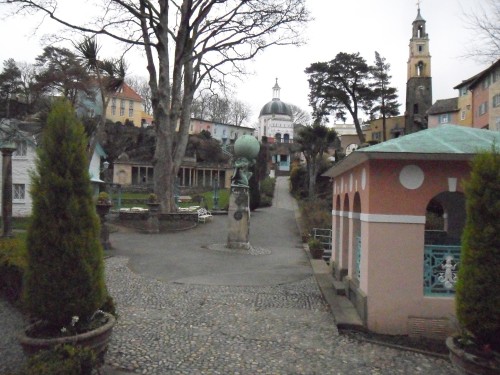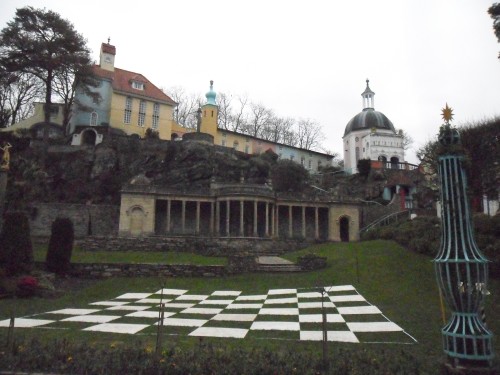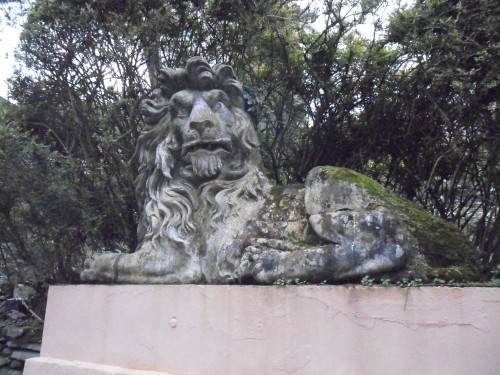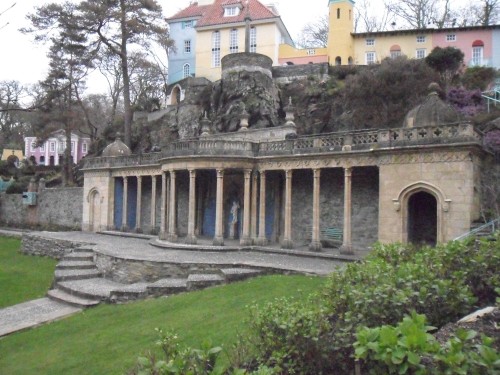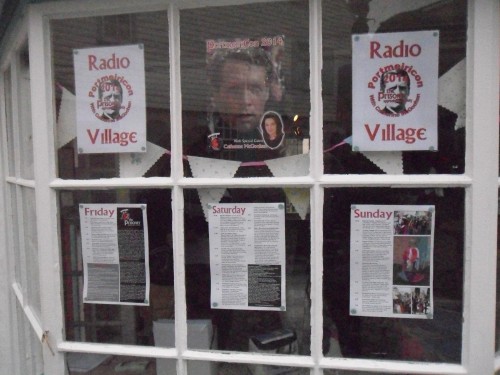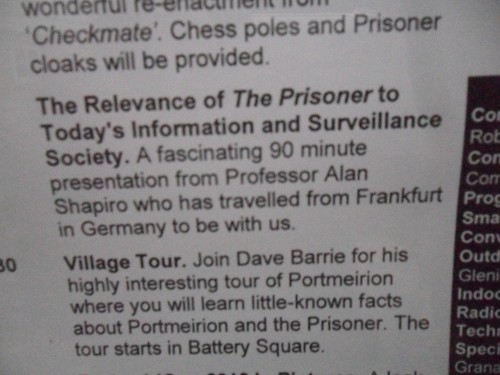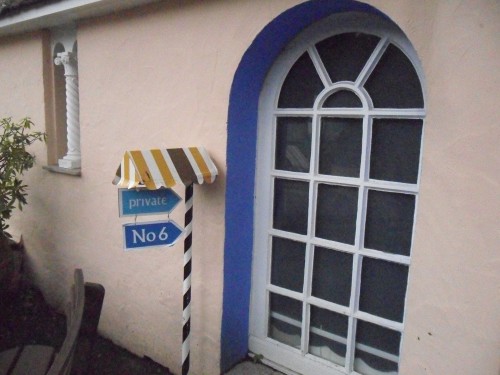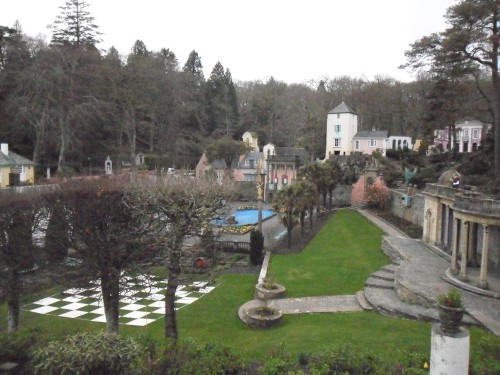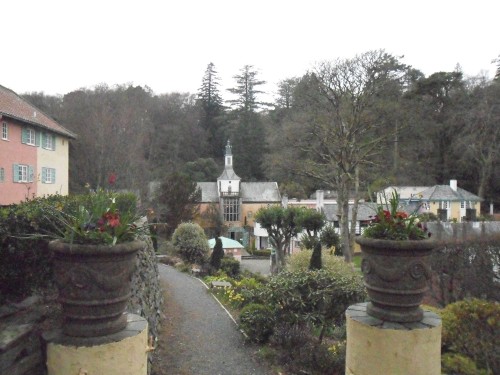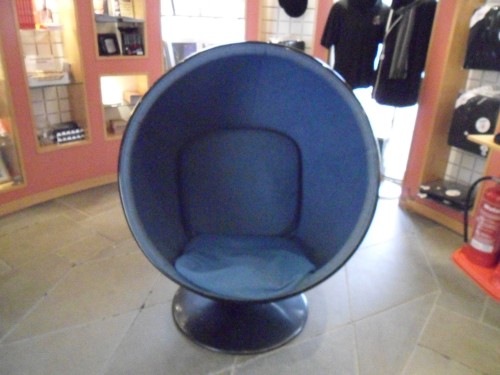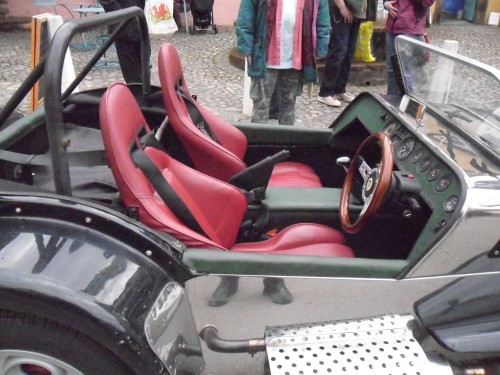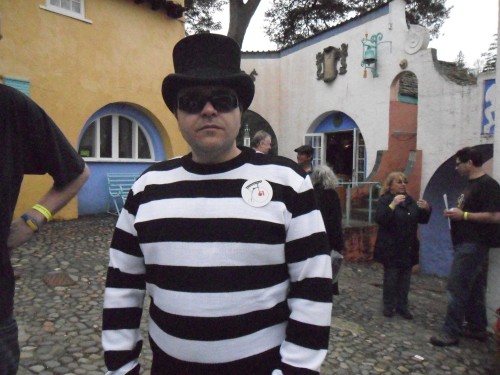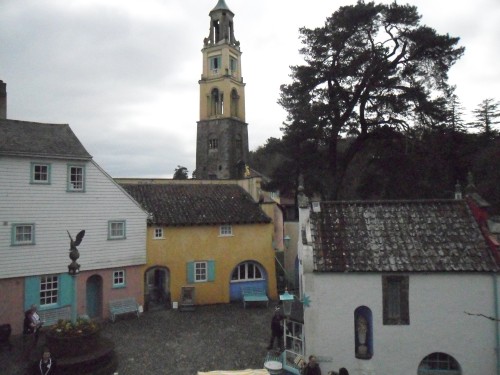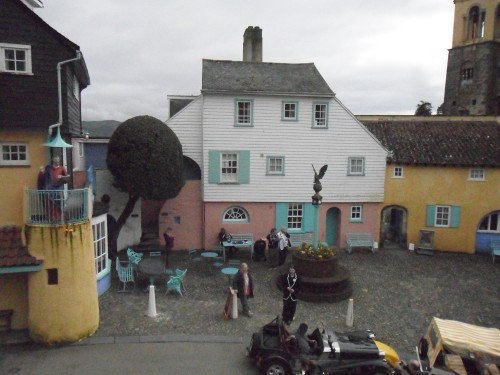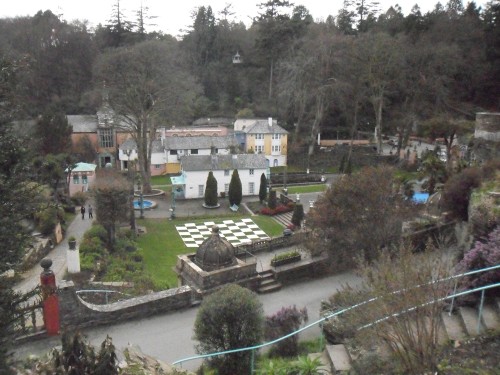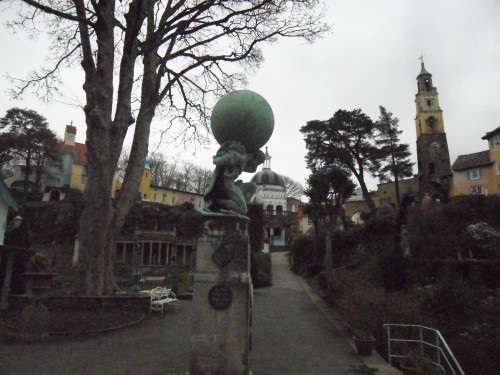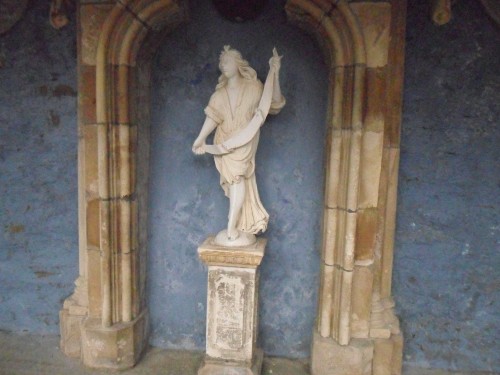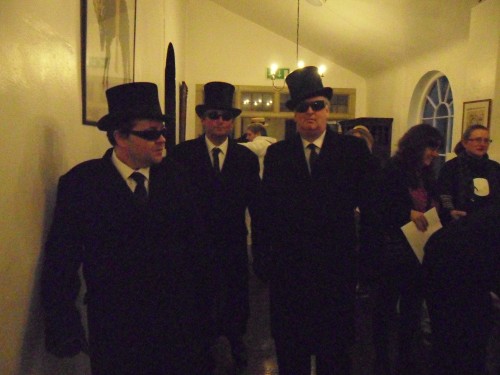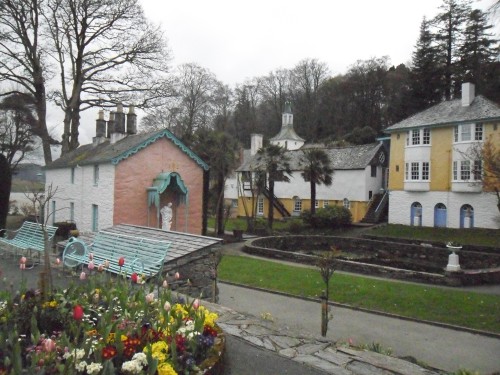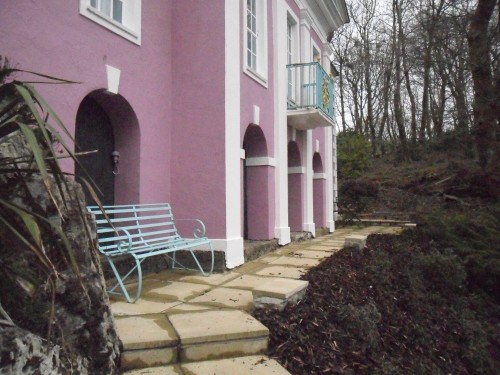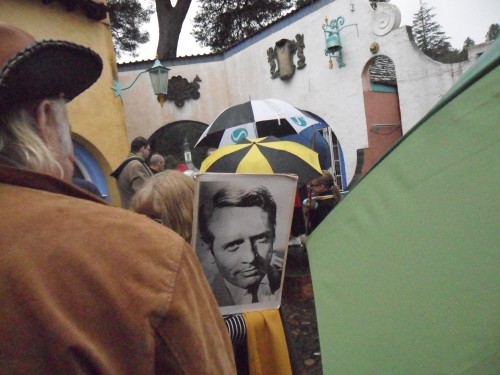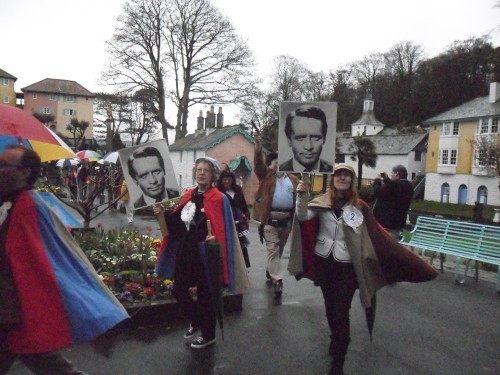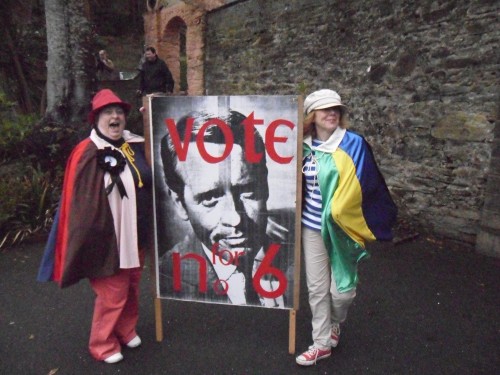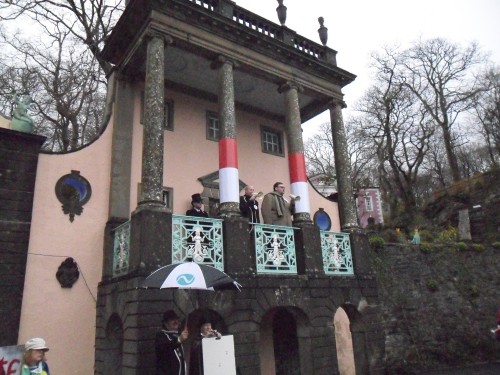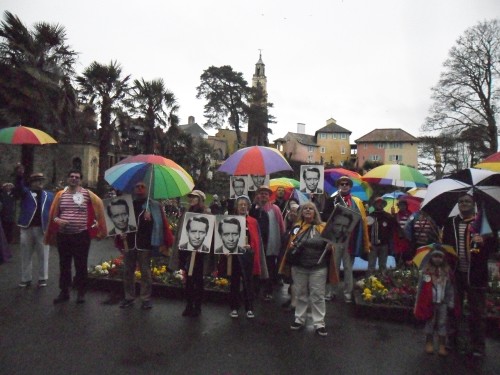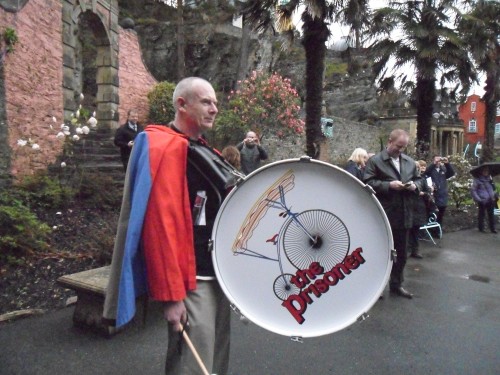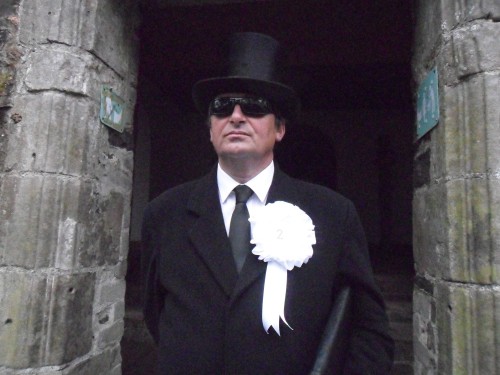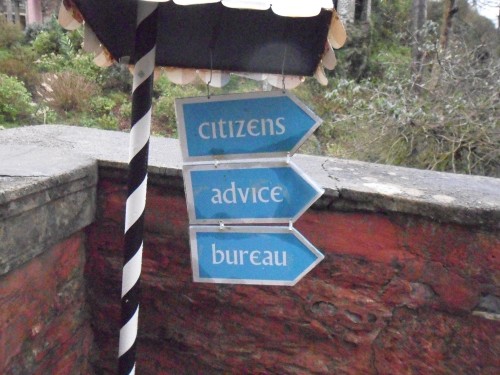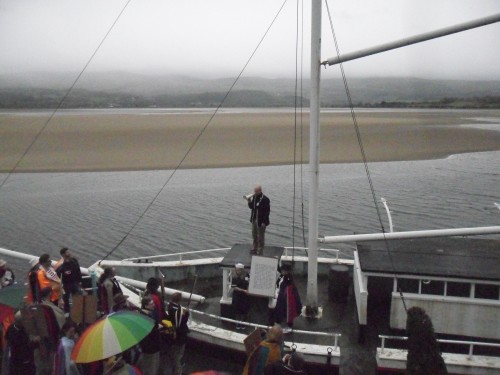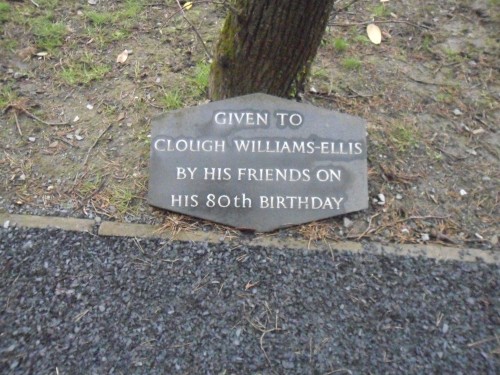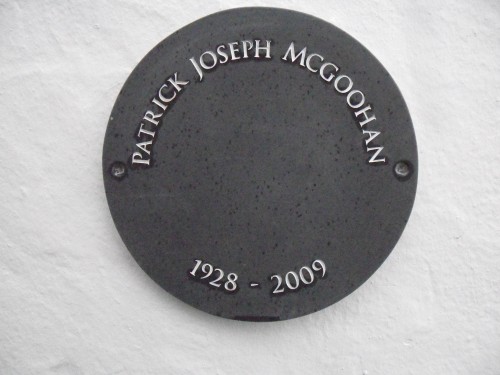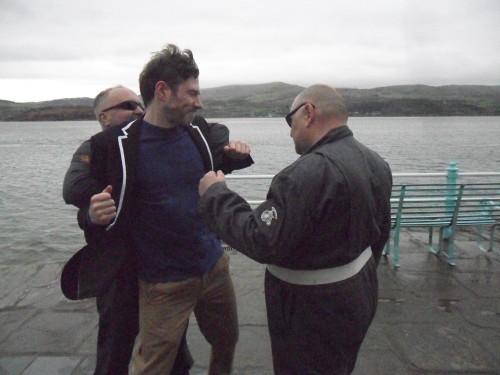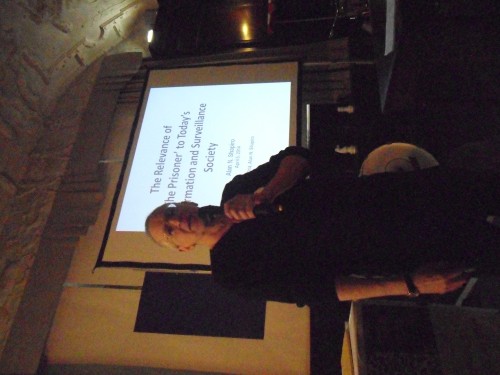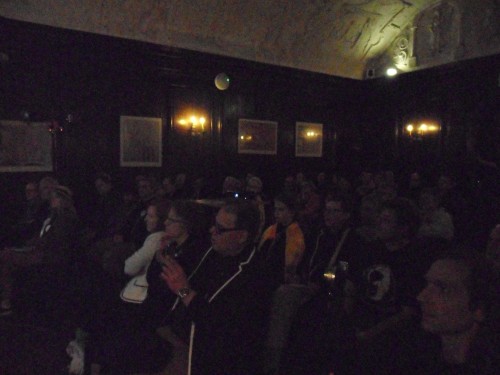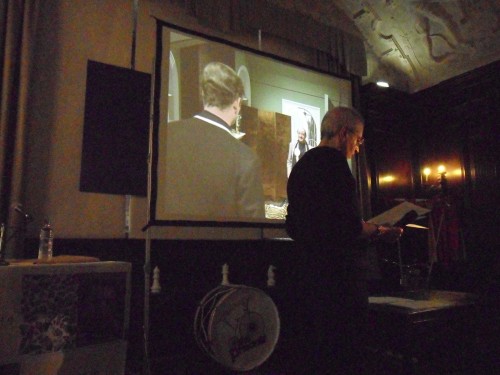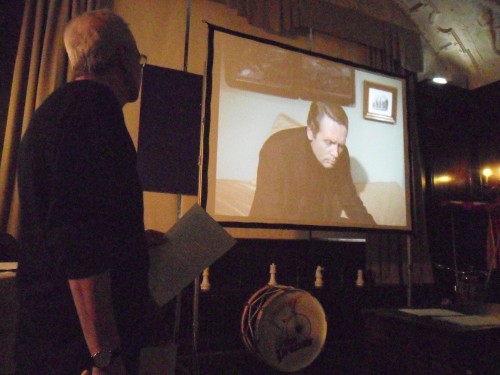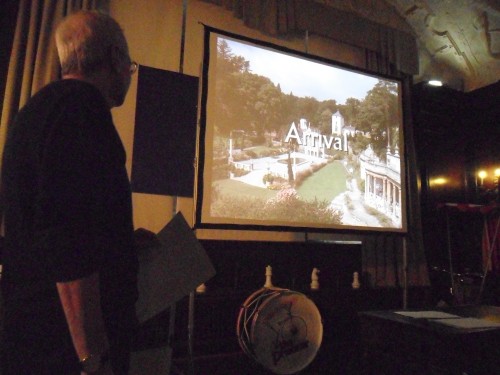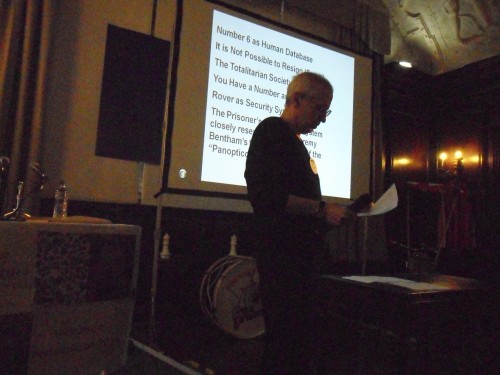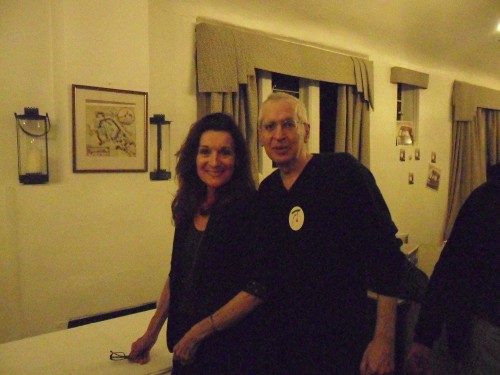photos: Portmeirion, Wales, April 2014
I want to thank co-authors Nolan Bazinet and Nicole Maggio.
I teach “computer programming for artists” and media theory at an art and design university in Germany. I do a kind of media sociology of The Prisoner. I relate The Prisoner mainly to George Orwell, Marshall McLuhan, Michel Foucault, Jean Baudrillard, and Vilem Flusser.
The information society. We want information.
The Global Village.
Surveillance.
The Prisoner is rooted in social discourses belonging to the 1960s era. Yet it is also highly relevant as a social commentary on conditions of life in the twenty-first century. This is a hybrid.
The present work will read the 17 episodes of The Prisoner as literature, and attempt to demonstrate the complexity of the texts which they generate.
McGoohan fuels the allegory by keeping both the fictional location and the real production location of The Village ambiguous. In “The Chimes of Big Ben” we find out from Nadia that The Village is in “Lithuania, on the Baltic, thirty miles from the Polish border”. However, this seems to be untrue. In “Many Happy Returns” the location of The Village is calculated (through very complex indirect reasoning related to information about Number 6’s long journey on a raft) by a Naval Commander and RAF Group Captain to be “off the coast of Morocco, southwest of Portugal and Spain”. (Nicole Maggio)
We can assume the latter to be the correct fictional location as the Prisoner sees The Village with his own eyes in this geographical area when traveling with a pilot in a military jet. It is not until the closing credits of “Fall Out” (the seventeenth and final episode) that we are made aware that The Prisoner was filmed on location in Portmeirion, North Wales. (Nicole Maggio)
According to this legend of The Prisoner that McGoohan himself established, Number 6 embodies the obstinate individual who remains relentless in his quest to escape the confines of the mysterious Village. We agree that this interpretation is one current that is running through the text of The Prisoner, but we believe that a second current exists as well.
We will do a “secondary” reading of the “text” of The Prisoner, which will then become our “primary” reading. It is an idea of freedom in political theory that is influenced by Michel Foucault, whose theory of freedom is not a liberal theory.
Foucault was most well known for his theory and studies of relations of power in modern society. In “The Ethics of Care for the Self as the Practice of Freedom,” Foucault writes:
“One must observe that there cannot be relations of power unless the subjects are free. If one or the other were completely at the disposition of the other and became his thing, an object on which he can exercise an infinite and unlimited violence, there would not be relations of power. In order to exercise a relation of power, there must be on both sides at least a certain form of liberty.”
In contrast to the opposition between power and freedom articulated in liberal political theory, where freedom is generally considered abstractly as being the absence of external constraints imposed by the state or other large institutions/organizations, power for Foucault operates in and through everyday life practices, and the discovery of freedom is to be made in understanding how we have been manipulated in many of the most intimate areas of our personal existence, and how we can concretely and creatively transform that. This liberation is a process of experimentation, and we will never know at the outset of each freedom-forging experience what the outcome is going to be. But the question that really interests us is: how do we accomplish this radical progressive transformation in the age of information and online social media? How do we achieve the next step in what social media can be? How do we get beyond the current situation where we are Prisoners in a Baudrillardian-Foucaultian hybrid system of commodified consumerism that William Bogard has called the simulation of surveillance, and in post-Orwellian networks of self-surveillance and mutual surveillance?
So there is a certain limit to our interest in Number 6 as a figure of classical liberal individualism rebelling against the totalitarian collective.
We are also interested in Number 6 as someone who is practicing freedom in the here and now (this was also the essence of Paul Goodman’s anarchist theory of freedom), creatively overturning and transforming (I think of the French situationist concept of “détournement”) the conditions of life which are given to him by the totalitarian “media society” of The Village.
Foucault famously said: “As in judo, the best answer to an adversary maneuver is not to retreat, but to go along with it, turning it to one’s own advantage, as a resting point for the next phase.” This is well symbolised in The Prisoner in Number 6’s twice weekly judo-and-trampoline sports practice.
The episodic story of The Prisoner unfolds in the opening two-and-a-half-minute credit sequence, with stirring theme music. This sequence frames the story for viewers by including events the protagonist experiences prior to waking in The Village. This narrative is shown more at length in the initial episode of The Prisoner: “Arrival”. After McGoohan’s character resigns from his position as a high-ranking government agent, he drives his Lotus 7 with determination back through the city of London to his townhouse. Unaware that two sinister men driving a hearse follow him home, the character without a name packs his suitcase with contents that include travel brochures of faraway countries where he would like to vacation. Then he falls faint onto his bed after inhaling a gaseous agent released through the keyhole in his front door. In the following scene, he wakes up in an apartment in The Village, an exact duplicate of part of his London dwelling. (Nicole Maggio)
This visual preamble elicits questions including: Who is this man? Why did he resign? Where is The Village? How did he get from London to The Village? And, who is the supreme authority of The Village? (Nicole Maggio)
Every episode except for “Living in Harmony”, ”The Girl Who Was Death”, and “Fall Out” uses this opening credit sequence, which many consider to be the greatest opening sequence in television history.
In order to envision the place that the Prisoner (McGoohan’s character) so desperately wants to escape from, a brief description of The Village is necessary. The Village is a nameless place systematically referred to as “here” or “this place.” Sometimes it is called an “international community”. The Villagers themselves are also nameless and referred to solely by their assigned number. The Prisoner is Number 6. The Village comes complete with a video surveillance system, telephone service, radio station, television station, and daily newspaper, the Tally Ho. Each Number lives in his or her own “private” residence. All are routinely monitored via surveillance video, strategically positioned throughout The Village. The Villagers often wear colourful costumes to complement and enhance their environment. The Village logo is that of the Penny Farthing (the first bicycle, dating to the late nineteenth century – a high-wheeler with a large front wheel and a much smaller rear wheel) emblazoned on canned food products, on awnings and on personal identification badges, etc. There is even a local Mini Moke Taxi service, with taxis like golf carts. (Nicole Maggio)
On the surface, The Village appears to be a democratic society offering forms of entertainment (marching bands, costume balls), hospitality services (a cafe, a general store), various forms of media, and government organizations (Citizens Advice Bureau, Town Hall, Labour Exchange, Hospital, and a Council that claims to be “democratically elected”). Located at the hub is the Green Dome housing Number 2, the leader of The Village bureaucracy. As dictator, Number 2 answers only to Number 1. The identity of Number 1 remains unknown until the final episode, “Fall Out”. (Nicole Maggio)
Just as Village authorities seek “information” and just as the Prisoner stops at nothing to hold onto his own personal “information”, “the key ‘commodity’ in the modern world is frequently said to be ‘information'”
The Village is the ultimate in the indoctrination and subjection of the individual. The Establishment has taken over entirely. Individual freedom is dead. People no longer want to think for themselves, even if they are capable of doing so. The Prisoner of the title is the one man who is resisting. Or is he? That is one of the main questions that we will pose in the present study? And freedom of the individual, one feels, is what McGoohan is driving at. But is this a classical liberal conceptualization and enactment of freedom of the individual, or is it a new idea about freedom of the individual?
The car, speed, and the open road are metaphors of illusory freedom in The Prisoner. Number 6, before he is abducted and brought to The Village, is seen driving a classic Lotus 7 that he built himself. Number 6 is taken away from his Lotus 7 and put into a situation where he is denied the privilege of owning a vehicle. The Prisoner driving on the city street becomes an illusion of freedom.
Another iconographical artefact that reminds Village prisoners (and specifically Number 6) about this illusory freedom is the statue of Atlas. From Number 6’s point-of view (in “Arrival”), we see the Greek god crouched down carrying the planet earth on his shoulders. One meaning connoted by this statue is that man, no matter how hard he fights and how much strength he possesses, is always bowed down by the weight of the world. Another meaning could be that, since Atlas was made to carry the world on his back as punishment for battling against Zeus, Number 6 too will be punished if he fights against authority by not complying with the rules of The Village. (Nicole Maggio)
Throughout the series, it is strongly implied that Number 6 and Number 1 are one and the same. In “Arrival”, when the Prisoner asks who Number 1 is, Number 2 replies, “you are Number 6”. It appears as if Number 2 is purposefully avoiding any direct answers. But it can also be read as: “you are, Number 6”. The Prisoner is being directly told that he is Number 1. (Nicole Maggio)
When the boundaries of time and space collapse in McLuhan’s Global Village, everyone can be simultaneously everywhere. McGoohan’s Village visually illustrates this notion in several ways. The Prisoner exemplifies this conclusion in two manners: 1) the different historical periods alluded to in the content of the episodes; and 2) the vast number of historical periods alluded to by the several architectural styles in The Village.
In his mish-mash of architectural pieces from around the world, Sir Bertram Williams-Ellis was striving to create an atmosphere that elicits a feeling of everywhere and nowhere at the same time. Bertram Williams-Ellis was an English-born Welsh architect chiefly known as the creator of the Italianite village of Portmeirion in North Wales. He designed Portmeirion in the 1920s. (Nicole Maggio)
The database in The Prisoner, controlled by Number 2 (and presumably Number 1), consists of all the most detailed and intimate pieces of information on each and every member of The Village. The Prisoner is narrative metaphor for understanding many aspects of the contemporary sociological-technological situation of the hyper-network society.
Beyond its restricted mathematical meaning, or its technical meaning as signs or signals in information science messaging, information more generally, in the sociology of work and culture, is about abstraction and complexity. Workers in the information society, and consumers in the society of cultural citizenship, tend to handle patterns and representations rather than physical entities. Until now, information has been regarded as being like numbers, an ordered sequence of symbols, bits and bytes of data, a change in state of an object-oriented system, transparent signifieds only without the signifiers that shape the meanings, a bunch of facts on file, the transmission or contents of messages while ignoring the media – language itself – that structures the messages at the most intricate detailed level. Now that we are in the age of social media like Facebook, Wikipedia, Twitter, and blogs, how should sociology redefine what is information? How can social media consciously evolve to become more democratic and supporting of human freedom and human rights, rather than unconsciously becoming “totalitarian” in new ways that are reminiscent of Orwell’s Nineteen Eighty-Four or the social theories of Foucault and Baudrillard?
It is important to note that the media theorist Vilém Flusser, in his book Into the Universe of Technical Images, defines information in a positive way.
No President of the United States, no matter how “liberal” he or she may be, has the power to change anything significant. The real power resides with the military-industrial complex, the weapons industry, the big corporations, and the media, etcetera.
Number 6’s candidacy for the role of Village dictator is possibly merely an illusion. Number 6 is subliminally fed empty political platforms which he employs in his campaign: ”The community can rest assured that their interests are very much my own and that anything I can do to maintain the security of the Citizens will be my primary objective”. The crowd is also programmed to respond with cheers to whatever Number 6 says, thereby making the content of what he says irrelevant. The Prisoner explores how politicians have little power against the media that, for example, twist their words and their message. When Number 6 says “no comment” to most of the questions asked in an interview by the Tally Ho journalist Number 113, Number 113 records phrases and political platforms the Prisoner did not say or indicate in any way whatsoever. Subsequently, these are printed in the Tally Ho. (Nicole Maggio)
In a small town or Village environment, news travels fast since it does not have to go far to reach all of its residents. The Prisoner illustrates the instantaneous connection between the creation and reception of news stories.
Upon arrival in The Village, the Prisoner has numerous questions which everyone around him refuses to answer. He is first informed by the maid, “It’s wiser not to ask questions”. The Village has its own set of slogans, which also serve as rules. On The Village walls are posted: “Questions are a burden to others; answers, a prison for oneself”, “A still tongue makes a happy life”, and “Humour is the essence of a democratic society”. These slogans resemble Nineteen Eighty-Four‘s maxim “WAR IS PEACE; FREEDOM IS SLAVERY; IGNORANCE IS STRENGTH”
It is also possible to interpret “The Prisoner” through Freudian psychoanalysis. The Prisoner’s real enemy is his own psyche and escape is impossible.
The death drive?
“No number, no call.”
Please take a number and have a seat.
Heading out to the beach… “I am not a number, I am a free man!” Rover the BLOB awaits.
Jeremy Bentham’s “Panopticon.” Michel Foucault, Discipline and Punish: The Birth of the Prison.
You can take the boat out for a spin…
Or dream of the mobility you once had in London…
Honoring the architect…
Honoring the actor, writer, producer and director.
Beaten by Village thugs…
And now for my “speed learning” technique…
In one sense, this new form of education is the consummate version of a disciplinary and scholastic system that perpetuates power as discussed by Foucault in Discipline and Punish. Foucault discusses how disciplinary practices in the school system were crucial to creating citizens who could self-discipline themselves. Examples of this are desks being set in rows, the division of the day into periods, the examination process, etc. These are all methods of creating self-discipline. They demonstrate the microphysics of power evident in the school system since the 18th century. One could also point out the choice of curricula and the knowledge that is handed down to students as another example of power in that it frames their ideas/knowledge of the world. In relation to these traditional aspects, Speed Learn goes beyond such demonstrations of power and is even more microphysical than the above disciplinary techniques as it reaches the student directly in their brains. There is no hassle of forcing students to study, learn and be tested in order for them to retain information. On the other hand, does the absense of ‘testing’ as a mechanism for enforcing power paradoxically create a certain kind of freedom? If the traditional practices of the education system were microphysics of power to make students adaptable, then Speed Learn is the ultimate tool in promoting complete docility. (Nolan Bazinet)
After the initial mind reading activity at the beginning of the episode “The Schizoid Man,” Number 24 then takes a picture of Number 6, which we later find out serves as Number 6’s only proof that he is indeed Number 6 and not Number 12. It is interesting that this technical image, this virtual double, serves as the proof in elucidating the difference between Number 6 and his ‘body double’. In other words, the virtual serves as the key to unlocking the confusion of the physical/real world. (Nolan Bazinet)
He wakes up in an apartment in The Village, an exact duplicate of part of his London dwelling.
Within the confines of the small Village, Villagers are subjected to a loss of personal freedom and privacy. Their humanity has been diminished. They have become mere numbers. Their resistance has been compromised, and their psyches so weakened that conformity is inevitable and escape is futile. The Prisoner suggests that it is impossible for the individual to flourish in a totalitarian regime. Or does it suggests the opposite of this? We shall argue that the “secondary text” of The Prisoner is pointing the way towards how one could indeed flourish within the very specific new kind of totalitarian society that has emerged within the “information” and media society of the early 21st century.
There’s a man who leads a life of danger
To everyone he meets he stays a stranger
With every move he makes, another chance he takes
Odds are he won’t live to see tomorrow
Secret agent man, secret agent man
They’ve given you a number and taken away your name
Beware of pretty faces that you find
A pretty face can hide an evil mind
Ah, be careful what you say
Or you’ll give yourself away
Odds are you won’t live to see tomorrow
Secret agent man, secret agent man
They’ve given you a number and taken away your name
Number 23 with the actress Catherine McGoohan.
